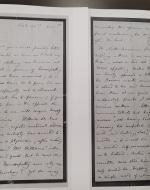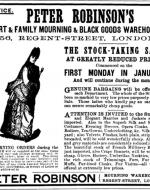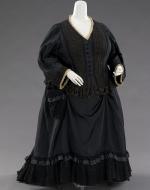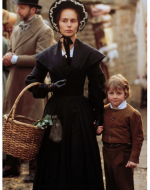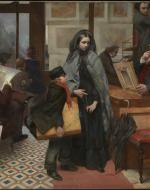Created by Anastasia Rogozinski on Sun, 11/13/2022 - 12:07
Description:
Death loomed over the Brontës from a very young age. The siblings' mother died when they were all very young, followed by the death of the two eldest siblings: Maria and Elizabeth. This ever-present threat of death influenced their writing--death itself and various mourning rituals, specifically the donning of black clothing, frequently appears in their novels. Through studying the mourning process, including the way others were alerted to the death of a family member or friend, we can see how all-consuming death was during the Victorian era and why it has such a presence throughout the Brontë novels.
Victorian Mourning Envelope with Address, The Victorian Web. Mourning stationery, especially envelopes, were very common during the Victorian Period. During this time, the recipient of the letter had to pay in order to receive it. These mourning envelopes, with black trim around all of the edges, served as a message to the recipient that someone had died and that they needed to find the money to pay for the letter. Consequently, many people of the lower reaches could not afford to pay for their letters. Mourning letters frequently appear in the Brontë novels. For instance, in Wuthering Heights (1847), Emily Brontë writes, "A letter, edged with black, announced the day of my master's return. Isabella was dead; and he wrote to bid me get mourning for his daughter" (153). Throughout the Victorian period, there were many methods of non-verbal communication; the mourning letter was just one method. This image is from an article on The Victorian Web by Catherine J. Golden, picture taken by Michael Marx. https://victorianweb.org/technology/letters/7b.html
Excerpts of Letters from Charlotte Brontë to Ellen Nussey Talking About the Death of Her Siblings, 1848-1854, The British Library. Writing letters was a common practice in the Victorian era, and it was the most popular form of communication among people. Charlotte frequently wrote to her friends. Sadly, her siblings died in quite quick succession of one another, leaving Charlotte as the only remaining Brontë child. These excerpts from the letters she wrote to her close friend Ellen Nussey show how the death of her siblings affected Charlotte. It is important to notice that the paper Charlotte is writing on has a black edge, which signifies to us and, at the time, to Ellen Nussey that Charlotte is in mourning. This image is from the British Library, https://www.bl.uk/collection-items/five-letters-from-charlotte-bront-to-...
Advertisement for Mourning Attire, Illustrated London News, 8 January, 1887, The Victorian Web. Mourning etiquette in the Victorian period included many rules. Frederick Warne published Manners and Rules of Good Society, Or, Solecisms to be Avoided by a Member of the Aristocracy in 1888 (https://victorianweb.org/history/mourning/6.html), which explains all of the different rules regarding mourning for the upper reaches. For example, full mourning and half-mourning involve wearing degrees of black. Additionally, a widower had a different period of mourning than a son or a daughter or a brother or sister. This image is an advertisement that appeared in a London newspaper. It details a "warehouse" where one could go to buy the correct mourning clothes. And, because death was such a prominent, constant event for the Victorians, this advertisement (and warehouse) was no doubt very successful. This image from the Hathi Trust Digital Library in the University of Chicago Library is on The Victorian Web, https://victorianweb.org/art/costume/mourning/3.html.
Mourning Dress Worn by Queen Victoria after the Death of Her Husband, 1894, The Metropolitan Museum of Art. The practice of wearing black mourning clothes reached its peak during Queen Victoria's reign. In fact, Queen Victoria was the one to set the standard for this practice after her husband, Prince Albert, died in 1861. Queen Victoria continued to wear black for the rest of her life, mourning her husband. Therefore, it became a social expectation to wear black for anywhere from three months to two and half years after a loved one or monarch passed away. This custom was practiced at all class levels. Clothes were usually available at all different price points, but those who still could not afford the correct clothing would dye their regular clothes black. This image, from The Metropolitan Museum of Art, shows one of the dresses Queen Victoria wore to mourn her husband. The white trim and other delicate details indicate a state of half-mourning, though the Queen wore this garment about 33 years after Prince Albert's death. https://www.metmuseum.org/art/collection/search/155840
Still from BBC Adaptation of The Tenant of Wildfell Hall, 1996. This still from the 1996 BBC Adaptation of The Tenant of Wildfell Hall (1848) by Anne Brontë depicts the main character, Helen Graham, with her young son Arthur. She is shown wearing all black, signifying that she is acting as widow Helen Graham, allegedly mourning the loss of her husband. The subtle touches of white on her hat might suggest that she is in the half-mourning stage where one does not have to wear all black. This detail implies that it has been around a year or so since her husband supposedly died. Regardless, the people around Helen can tell that she is in a state of mourning. All of the Brontë sisters would have been familiar with the expectations surrounding the custom of mourning clothes. While many of these mourning customs seem odd today, they were constant in the Victorian period, and through the inclusion of such customs in the Brontë canon, we glean how commonplace these practices were and how often death occured in the framework of Victorian society.
Emily Mary Osbourn, Nameless and Friendless, 1857, Wikipedia. Mourning in Anne Brontë's The Tenant of Wildfell Hall is a significant subject throughout the novel. Helen arrives at Wildfell Hall wearing all black clothes to signify she is a widow in mourning. Helen Graham's powerful character may have influenced the painting Nameless and Friendless, according to writer Samantha Ellis. This painting shows a woman dressed in black, suggesting a state of mourning. Additionally, she is showing a man a painting of her own, and her young son is also with her. One can imply that the figure in the painting is hoping to use art as a way to support herself and her son, just as Helen Graham does in the novel. Nameless and Friendless reveals how the influence of The Tenant of Wildfell Hall reaches far beyond the novel, influencing other writers and artists. This image is from Wikipedia, https://en.wikipedia.org/wiki/The_Tenant_of_Wildfell_Hall



